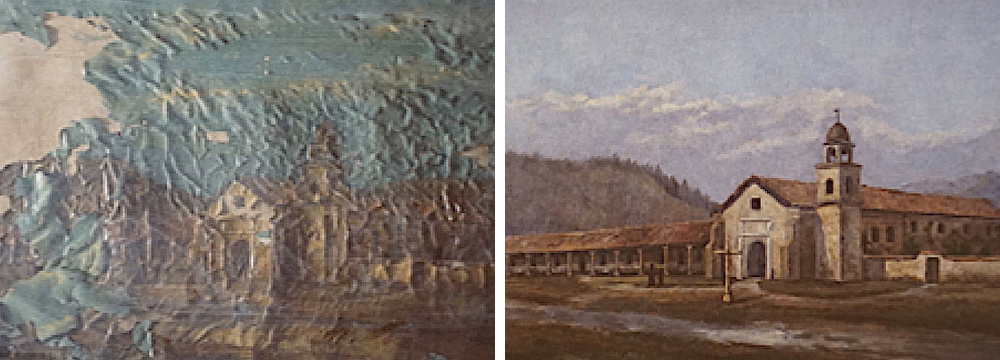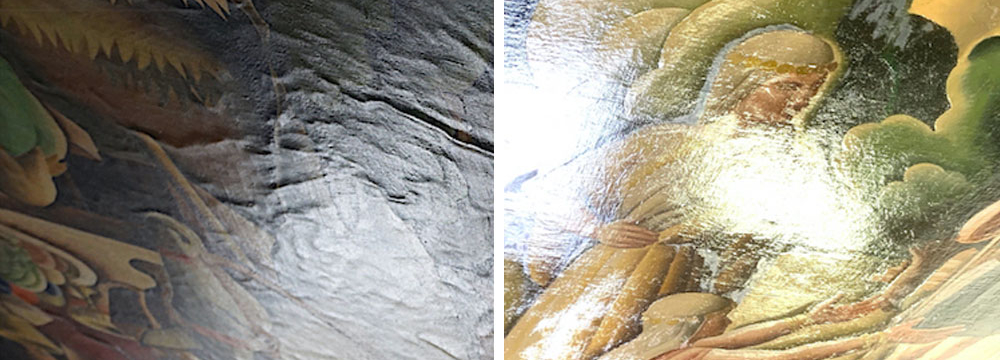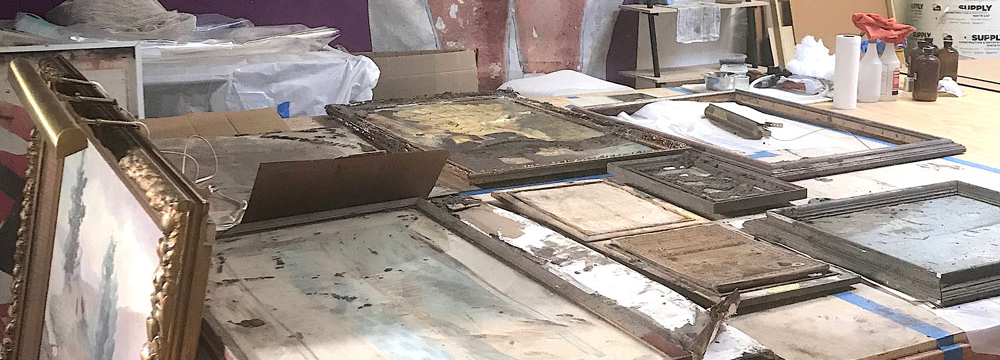It may surprise you that many of the paintings of ships that highlight a particular ship with its flags and name clearly visible are actually a portrait of the ship. Portraits of ships were very popular at the middle and the end of the 1800s. It is also interesting to know that many of these paintings of ships hung in the cabins of the ship in the painting. Therefore some of these paintings have had serious time at sea.
It is very common, therefore, that maritime paintings have been in very bad conditions and circumstances. Bouncing around the ocean along with the ship is only part of the problem. Of course high humidity and actual water are serious problems. And you can imagine as things swing around the cabin in high seas how easy it is that these paintings on canvas get punctured and ripped. If you don’t already know, 19th century oil paintings (of all kinds of paintings from all countries) have extremely brittle fabric as they age… and rip easily.
Another serious setback to the normal health of paintings of ships is the fact that people on the ships are used to fixing everything themselves so when the painting needed cleaning or needed a rip repaired or needed new varnish it was worked on by the handy guy on the ship with poor quality materials and bad restoration techniques. They had no idea what materials and art conservation techniques helped or hurt long term preservation.
It is, in fact, surprising to find a 19th century maritime painting that hasn’t been treated very poorly and repaired very poorly.
Up to now I’ve been talking about portraits of ships for ocean vessels. You can imagine that river and lake vessels would not be so hard on a painting as in the ocean. But still, life on a boat is not ideal for the long term preservation of an oil painting.
Given how common inept restorations are on these types of paintings, some of the common things that I’ve encountered may be good for you to know:
- If you own a maritime painting and have to get an appraisal. The supposed value could be quite different than the actual value once the actual condition is determined. For instance, one of the types of damage that first results in a substantial decrease in value is damage to the rigging from cleaning. Redrawing or repainting the missing rigging does not restore the value on the open market, according to the dealers that I have worked with.
- If you are thinking of buying a painting of a ship, this “tip” could save you $10,000’s either from paying too much or to give you something to use to negotiate.
Consider also the following condition issues on maritime paintings:
- Other easily damaged details are white water caps and foam in the water easily removed when paintings are scrubbed.
- 19th century maritime paintings often are painted with a porous paint quality that is easily stained in the clouds in the sky. In addition the ground layer or the gesso layer under the paint is often easily stained while aging as it was common to brush the back of the painting with the resin that discolored badly. Most of the pigments on these paintings are transparent and so the staining of the gesso or ground layers show through.
Almost all of the old varnishes used to coat these paintings were resins and varnishes that were used on ships. That means they discolored very badly and do-it-yourself-urs find it very difficult to remove without damaging the original paint.
Once scrubbed, repainting is done with a big brush and oil paint, which of course, does additional damage and further erodes the value and authenticity. Here is short video showing some paintings that were in our art conservation lab recently. It includes the testimonial of a painting’s owner who decided to do a partial treatment to improve (remove the previous poor quality restorations) the appearance of just the water.
What do you think? How “worth it” is this type of partial restoration treatment?
Leave a comment and a thumbs up!
Contact info
Scott M. Haskins, Virginia Panizzon, Oriana Montemurro (Art Conservators)
805 564 3438 office
faclartdoc@gmail.com











This type of painting restoration is VERY worth the time and effort. I mean, how can you not take care of something so cool… and historical?! Plus, for collectors, it seems to me that those that have paintings like this, from that time period, will know exactly what the worth is.
Sarah, thanks for your enthusiasm. May I make a point though? Value is not always expressed in terms of money. Sometimes people are highly attached for emotional reasons (like an ancestor’s portrait) or maybe for historical reasons.
I have been a huge fan of these types of paintings for a very long time. It is nice to see that you can restore them to the point they can be enjoyed for many more years to come. Thank you for that, Scott!
I too, Richard, love the realism of the late 19th century. The Orientalists were fantastic.
What would you say the value of a painting is from around 1900 that is in good shape and not in need of repair or restoration?
Patricia. The matter is MUCH more complicated than that… a good appraiser can answer the question for you. Also interesting, would be a visit at an auction house when they do their public outreach day and appraise things for free.
Excellent video. You make some very good points in it and that is a great thing for those that want a painting restored!
I think we can all agree that fixing something yourself is not a bad thing, however, these people might not have realized how they were actually damaging the painting even more in doing so.
Roberta… this is usually the case with do it yourselfers.
The colors are so dull on paintings from that era. What can you do for a painting to bring out richer colors and contrast?
Joe, each country seemed to have a little different feeling about color and contrast. The answer to your question depends on whether it was painted dull or maybe is covered with a layer of grime, dirty varnish or is poorly restored and revarnished.
This is great news. With so many paintings that might need to be repaired, seeing these videos that you make are the only thing that makes me realize they can be saved. Great work!
Thanks Daisy. Its very satisfying work.
This is very good information! I am going to pass it along to a guy that I think will benefit from it greatly!
I really like to look at some of the paintings that you can find of ships from back then. Just being able to build something like that took just as much talent as painting one with such great details! Thank you for sharing this article with us.
I have a painting of an old coal boat that used to come to an area local to me. It seems to be faded, or something, but I am not sure if it is something that needs to be restored, or if that is just how the painting looks. How can I tell if I need it restored?
Mary, show it to an art conservator and ask an INFORMED PROFESSIONAL opinion. I, for instance, would look at it for you, do a cleaning test and an estimate and I would not charge you.
Great tips! These can really save a person some good money if they find themselves in a pinch with a painting they feel has been ruined!
You are so right Aubrey!!
Great article! I never really thought about the parts of the paintings that are actually “above” the original surface, like the water foam you mention. Scrubbing or cleaning could reduce that, in effect removing a part of the painting.
I have been reading through some of your success stories on your site here, but one thing I have been wondering is whether or not you were ever confronted with a painting that you could not repair or restore?
If the original paint is super easily dissolvable and the surface is really dirty or has a very hard varnish, then it becomes impossible without hurting the original paint… which would not be an option.
It is amazing to see what you can do. Thank you, Scott, for your service to the art world!
Thanks Darryl. It feels like our work is contributing to society.
There is a time when paintings are going to become harder to reproduce or “fix” as you do. What time frame is that in your professional opinion? Getting a painting from 1903 back to life might be a little easier than something painted in the last 10 years, right?
That’s a complicated question Aimee. “When” it was painted is not so determining as “what” it was painted with and the type of technique.
How do you know how much you can do to a painting to make it “better” again? I found a painting in my parent basement after my mom and dad died and it looks like it is in pretty bad shape in my opinion.
Well, it usually takes an in-person inspection. A guess by photo is not accurate unless the problems and the work are simple and straight forward
Another great ending to what could have been the end of art that was produced back in the day. Some people might take these paintings and throw them in the trash based on the condition alone.
I’ve got some great stories about that happening, Fred!
Thank you for sharing this video, Scott. Seeing what your company can do for paintings, whether huge murals or personal portraits, is amazing! Keep up the good work. One question, do you have someone that you are teaching these skills so they can take over one day for you?
Thanks Connie. Yes, it takes a team of people to make out lab work. There are several people to take over later.
I bet those that painted these paintings were never thinking about the long term effects of them being out at sea, right? I mean, they were displayed like a finger painting on a fridge and not preserved at all. It is nice to see that you can bring them back to an enjoyable, visually appealing piece of art!
Very good job Scott! It amazes me to see the talent that you put into your restorations! The people you help are happy and that much make you feel great.
Absolutely Joseph!